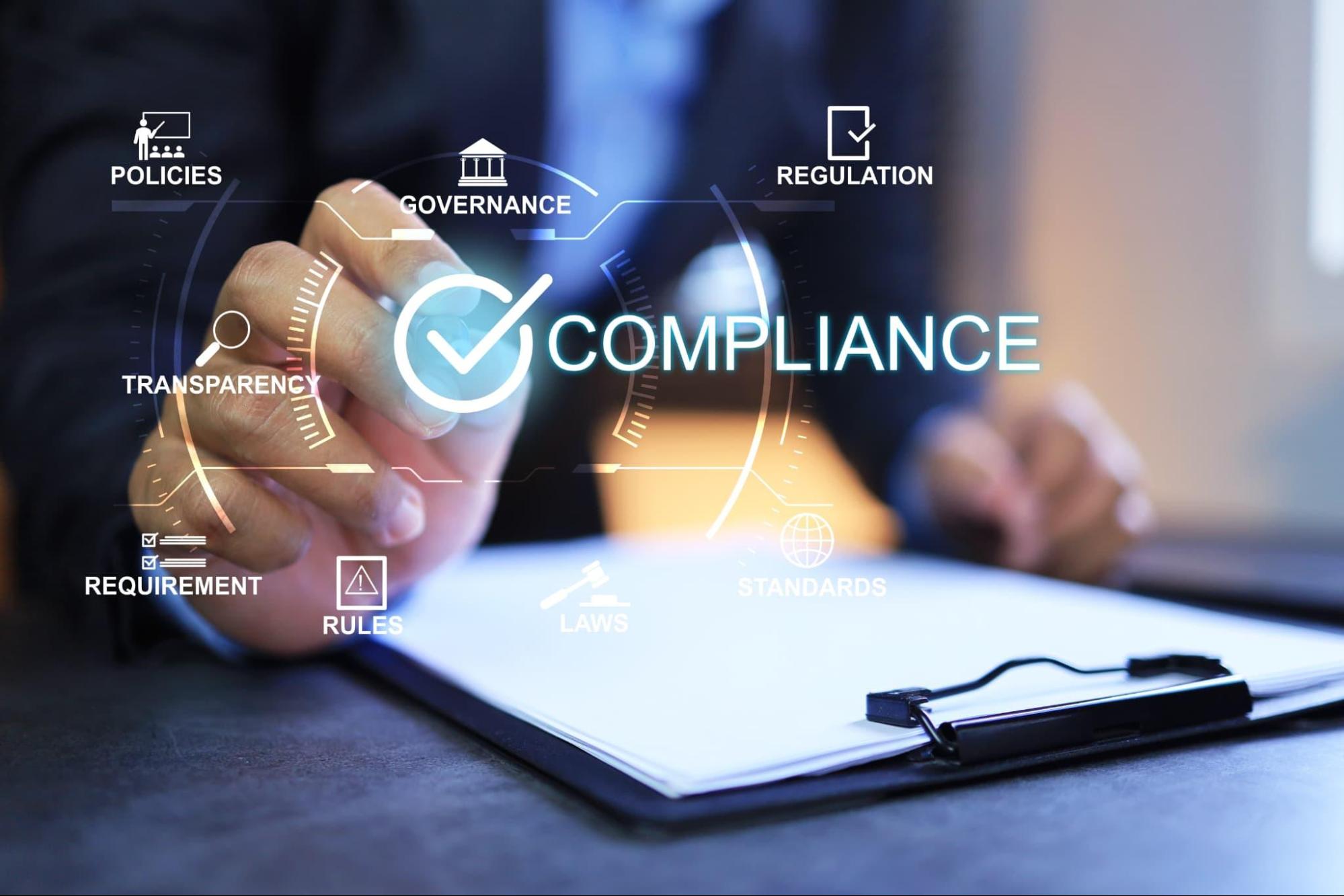table of contents
- 01.What is Information Security Governance?
- 02.Why is information security governance important?
- 03.The differences between information security governance, corporate governance, and IT governance
- 04.A framework to help establish information security governance
- 05.Supporting the proper management of information assets
- 06.Summary
Information security governance refers to the strategic framework and management process for properly managing information assets held by companies and organizations, protecting them from threats such as cyber attacks and internal fraud, and minimizing security risks.
By establishing information security governance, companies and organizations can expect the following benefits:
▼Benefits of implementing information security governance
- ・ Establish a common understanding of risks and countermeasures from management to frontline employees
- – Thorough compliance with laws and regulations, such as the Personal Information Protection Act (strengthening compliance)
- ・ Strengthening brand value and competitiveness through the implementation of appropriate security measures
To establish this information security governance, it is effective to utilize a framework consisting of the following five elements, which is published in the “Information Security Governance Implementation Guidance” published by the Ministry of Economy, Trade and Industry.
- 1. Direct: Management formulates basic information security policies and strategies and sets security goals for the entire organization.
- 2. Monitor: Monitor the implementation status of security measures and discover new risks and vulnerabilities early.
- 3. Evaluate: Regularly evaluate the effectiveness of measures and develop improvement measures as necessary.
- 4. Oversee: Management monitors information security measures across the organization and allocates appropriate resources
- 5. Report: Appropriately report incident occurrences and progress of security measures to management and related parties to ensure transparency.
In addition, there is a concept called “IT governance” that is easily confused with information security governance , but there are differences in the purpose and scope of the two, as follows:
| Information Security Governance | Monitor and protect all your company’s information assets (including non-IT information) |
|---|---|
| IT Governance | Monitor and manage optimal utilization of corporate IT resources |
Information security governance is a broad concept that encompasses not only IT systems but also confidential information on paper, physical security, and human risk management.
This article explains the need for information security governance and a framework to help establish it.
To summarize this article:
- Information security governance is a strategic framework and overall process for properly managing and protecting all information assets held by a company or organization and minimizing security risks.
- Reasons why security governance is considered important include “deepening common understanding of risks and countermeasures,” “enables thorough compliance with laws and regulations,” and “leads to improved brand value.”
- The information security governance framework consists of five parts: 1. Direct, 2. Monitor, 3. Evaluate, 4. Oversee, and 5. Report.
What is Information Security Governance?

Information security governance refers to the strategic framework and overall management process for properly managing and protecting all information assets held by a company or organization and minimizing security risks .
Without effective information security governance, the following risks may arise:
- ・Legal liability and loss of social credibility due to information leaks
- – Financial losses due to unauthorized access or cyber attacks
- – Business interruption due to system failure or data loss
Preventing these risks requires a comprehensive approach across the organization, including formulating information security policies, strengthening risk management, and providing thorough security education to employees.
Establishing information security governance not only strengthens security measures, but also ensures business continuity (BCP) and forms the foundation for sustainable growth.
Why is information security governance important?

There are three main reasons why information security governance is important:
- ・Establishing a common understanding of risks and countermeasures
- ・ Compliance with laws and regulations (strengthening compliance)
- ・Improved brand value and competitiveness
1. Establishing a common understanding of risks and countermeasures
In order to respond appropriately to information security risks, it is essential that the entire organization, from management to front-line employees, have a common understanding of the risks and countermeasures .
In particular, if management does not correctly recognize and manage risks, it may be difficult to take appropriate measures, which could lead to delays in security measures and vulnerabilities being left unaddressed.
Therefore, it is important that management takes the lead in establishing information security governance and builds a system that applies risk management to the entire organization. This will enable risk responses to be implemented under consistent policies and improve the security level of the entire organization.
2. Compliance with laws and regulations (strengthening compliance)
By establishing information security governance, companies can ensure thorough compliance with laws, regulations, and industry standards , thereby strengthening compliance.
Specifically, compliance with the following laws, regulations, and guidelines is required:
- ・ Personal Information Protection Act (Japan), GDPR (EU General Data Protection Regulation): Appropriate management of personal information
- ・ Cybersecurity Basic Act (Japan): Ensuring cybersecurity in companies and public institutions
- ・ NIST Cybersecurity Framework (USA): Risk-based guidelines for security management measures
A well-established governance system will enable appropriate policy formulation, risk assessment, and auditing, reducing the risk of penalties and litigation due to non-compliance with laws and regulations.
3. Improved brand value and competitiveness
Establishing information security governance is also an important part of corporate social responsibility (CSR)
. By demonstrating to customers and business partners that a company is implementing appropriate information security measures, the company can achieve the following benefits:
- ・ Improved reliability: Strengthening security measures will earn the trust of customers and partner companies.
- ・ Securing a competitive advantage: Establish a business advantage over companies with inadequate security measures
- ・ Improved market value: Cybersecurity measures are highly rated, increasing trust from investors and stakeholders
In particular, in high-risk industries such as financial institutions, medical institutions, and infrastructure-related companies , there are an increasing number of cases where information security measures are a condition of business transactions, and establishing appropriate governance is directly linked to the sustainable growth of companies.
The differences between information security governance,
corporate governance, and IT governance

Information security governance, corporate governance, and IT governance each have different purposes and play an important role in corporate operations. This article explains the differences between each type of governance.
Information Security Governance and Corporate Governance
Information security governance and corporate governance differ in the following ways:
| Information Security Governance | Focused on protecting information |
|---|---|
| Corporate Governance | Focused on ensuring transparency, fairness and efficiency in management throughout the organization |
Corporate governance refers to the systems and processes for ensuring the proper management of a company, with the aim of ensuring management transparency and maximizing the benefits to shareholders and stakeholders.
Specifically, it includes the following elements:
- ・ The process of formulating, implementing, and supervising business strategies
- ・ Establishment of compliance with laws and regulations and corporate ethics
- ・ Management supervision by the board of directors and auditing bodies
Strengthening corporate governance is required for companies to fulfill their corporate social responsibility (CSR) and maintain the trust of investors and business partners.
Information security governance, on the other hand, is a framework for protecting all information assets within a company and managing security risks. Its purpose is to maintain the three elements of confidentiality, integrity, and availability (CIA triad) and reduce the risks of cyber attacks, internal fraud, data leaks, and other threats.
Examples of specific measures include formulating security policies, incident response plans, and establishing CSIRTs and SOCs.
The major difference between corporate governance and information security governance is that while corporate governance involves the management of the entire company, information security governance is a strategic framework that focuses on protecting information and managing risks.
Information Security Governance and IT Governance
The differences between information security governance and IT governance are as follows:
| Information Security Governance | Manage and protect all your company’s information assets (including non-IT information) |
|---|---|
| IT Governance | Optimize the use of your company’s IT resources and help you achieve your business goals |
IT governance is a framework necessary for a company to effectively utilize information technology (IT) and achieve its strategic goals. Specifically, it includes policies and procedures for optimally operating a company’s IT infrastructure, systems, and software, and is intended to support the company’s long-term strategy.
IT governance covers a wide range of areas, including technology infrastructure and promoting digital transformation (DX).
On the other hand, information security governance covers not only IT but also paper documents, physical security, and human risks. For example, there are the following differences:
- ・ IT Governance: Responsible for IT strategies and infrastructure development to improve business efficiency
- ・ Information security governance: Not limited to IT, but also includes data protection and compliance measures
The difference between IT governance and information security governance is that IT governance has a strong technical perspective, while information security governance places emphasis on risk management and compliance.
A framework to help establish information security governance

According to the Ministry of Economy, Trade and Industry’s “Information Security Governance Implementation Guidance ,” the information security governance framework consists of the following five components:
- 1. Direct
- 2. Monitoring
- 3. Evaluate
- 4. Oversee
- 5. Report
Let’s take a closer look at how each element works.
1. Direct
This is the phase where management sets information security goals and priorities and disseminates the vision throughout the organization.
In order to spread information security initiatives throughout an organization, it is essential that management first present a clear policy and set organizational goals. Management must view information security not simply as a technical issue, but as a business issue directly linked to the company’s sustainable growth and improved competitiveness.
Executives are expected to determine and incorporate into their organization’s strategy the following:
- ・ Formulation of information security policy
- ・ Conducting risk assessment (which risks should be prioritized)
- ・ Selection of framework to be applied (ISO 27001, NIST, etc.)
2. Monitoring
The purpose of this phase is to continuously monitor whether the information security measures formulated within the organization are being implemented properly and to detect potential risks and the emergence of new threats early on .
Monitoring not only looks for signs of cyberattacks and unauthorized access, but also checks whether internal security policies are being adhered to. For example, real-time threat monitoring through the operation of a Security Operation Center ( SOC ) and regular training to raise employee security awareness are also part of the monitoring process.
It is also important for management to regularly evaluate whether investments in information security are working properly and whether they are affecting business efficiency, and reallocate resources as necessary.
3. Evaluate
Evaluate is based on the results of monitoring to determine whether the organization’s security measures are achieving the expected results. This evaluation process involves conducting regular risk assessments and reviewing whether existing measures are appropriate for the current threat environment.
In addition to internal security measures, organizations are also required to evaluate the security management status of outsourced companies and cloud service providers. By considering security risks throughout the supply chain and implementing appropriate audits and improvement measures, it is possible to ensure the safety of the entire organization.
4. Oversee
Overseeing is the phase in which information security measures are implemented appropriately and continuously checked to ensure they are functioning throughout the organization, and necessary improvements are made. Management, the board of directors, and the CISO (Chief Information Security Officer) use internal and external audits to verify that information security policies are being properly adhered to.
The role of oversight goes beyond simply evaluating current measures. It also requires the flexible review of policies and processes to respond to new threats and changes in laws and regulations, and the continuous improvement of the organization’s overall security level.
For example, as new technologies are introduced and migration to the cloud progresses, it is important to regularly verify whether existing security measures are adaptable and update them as necessary.
5. Report
Reporting is an important element of governance, as it involves regularly reporting information security initiatives and risk status to management and stakeholders.
The subject of the report includes the occurrence of security incidents and their responses, the progress of risk management, verification of the effectiveness of measures, etc. In order for management to make appropriate decisions, quantitative evaluations based on objective data are necessary, and for this purpose, it is effective to use KPIs (key performance indicators) and KRIs (key risk indicators).
In addition, disclosing information security initiatives both internally and externally can ensure corporate transparency and help increase trust from customers and business partners. In particular, in industries that require advanced security measures, such as financial institutions and medical institutions, regular reporting can help give business partners a sense of security and strengthen market competitiveness.
Summary
In this article, we have explained the overview of “information security governance” and why it is important to establish it.
Summary of this article
- Information security governance is a strategic framework and overall process for properly managing and protecting all information assets held by a company or organization and minimizing security risks.
- Reasons why security governance is considered important include “deepening common understanding of risks and countermeasures,” “enables thorough compliance with laws and regulations,” and “leads to improved brand value.”
- The information security governance framework consists of five parts: 1. Direct, 2. Monitor, 3. Evaluate, 4. Oversee, and 5. Report.
Establishing information security governance will enable appropriate management of security risks and the implementation of appropriate measures to protect an organization’s information assets. This will help to avoid serious risks such as loss of social credibility due to information leaks, business suspension, and penalties for legal violations.
With the increasing sophistication of cyber attacks and the expansion of cloud computing, the importance of information security in the business environment is increasing. Establishing and practicing security governance across the entire organization is now an essential requirement.

